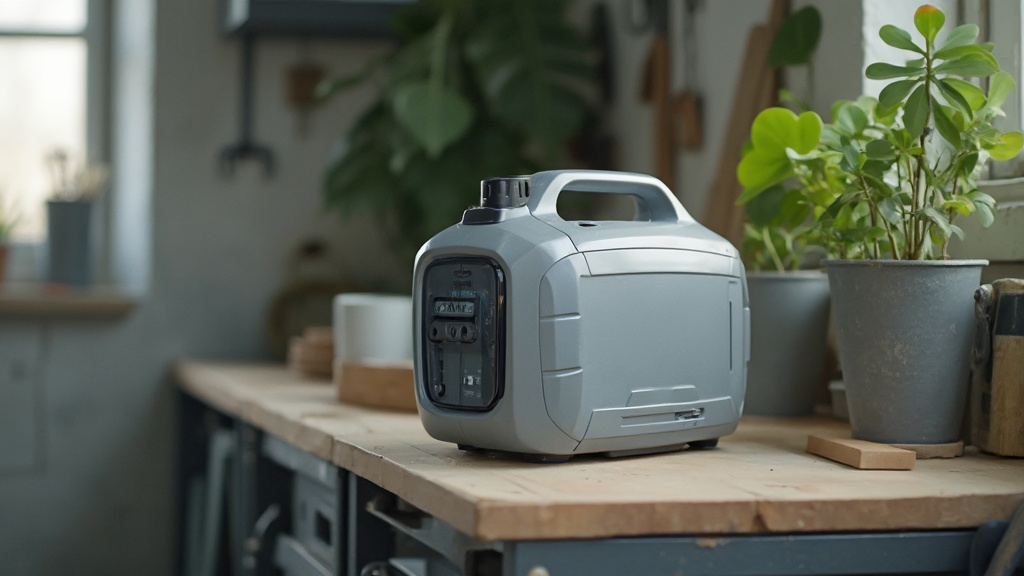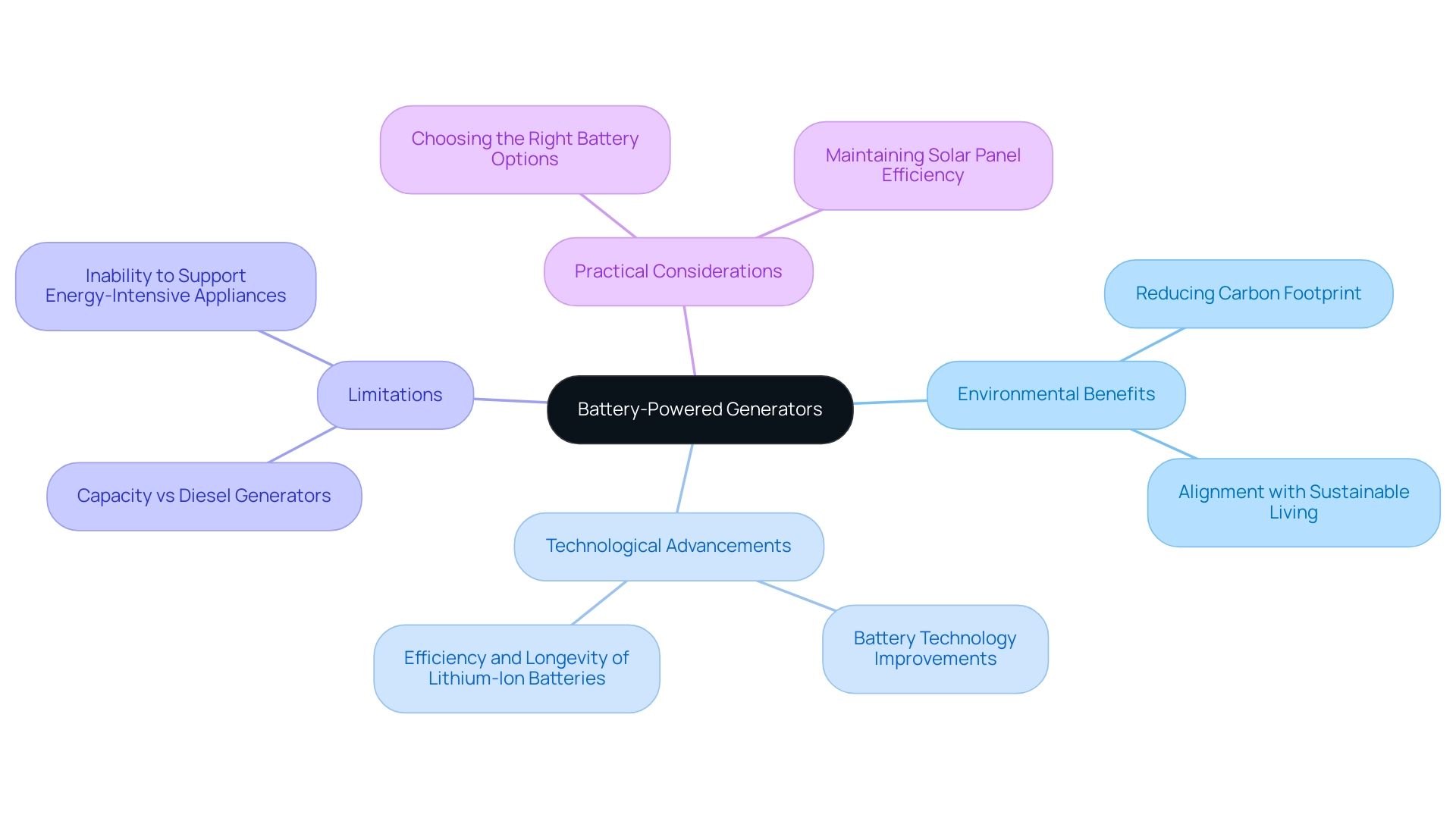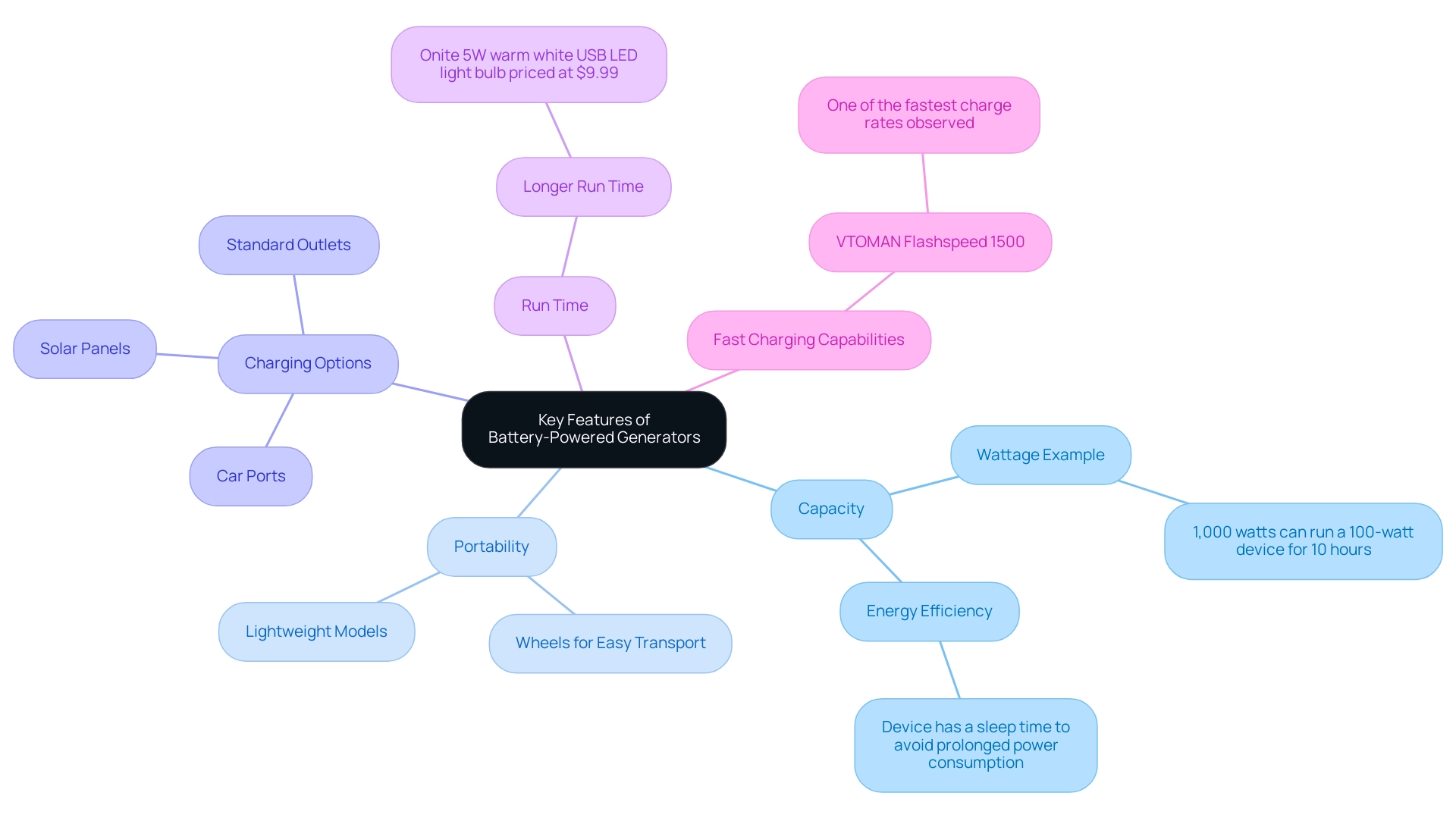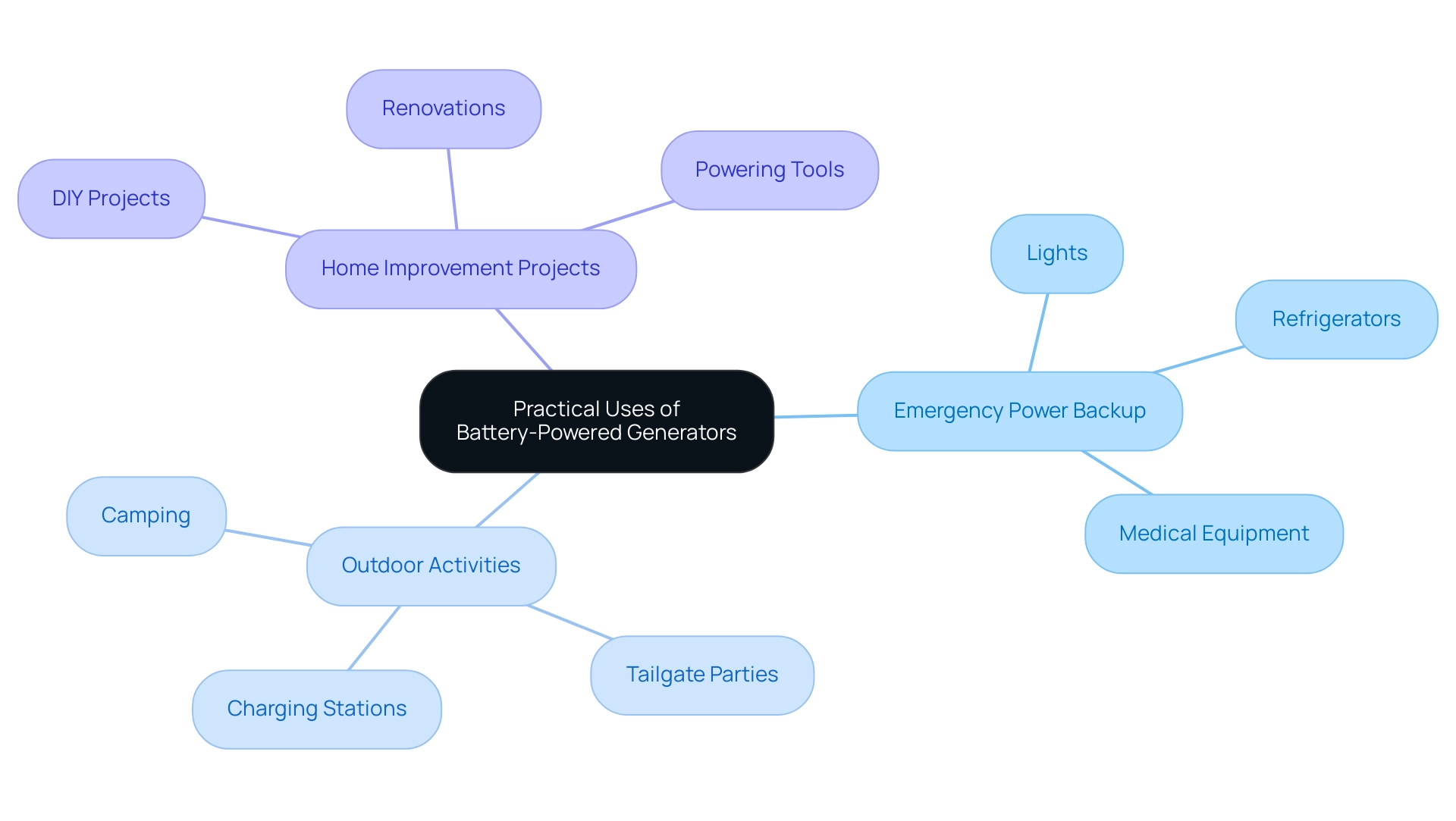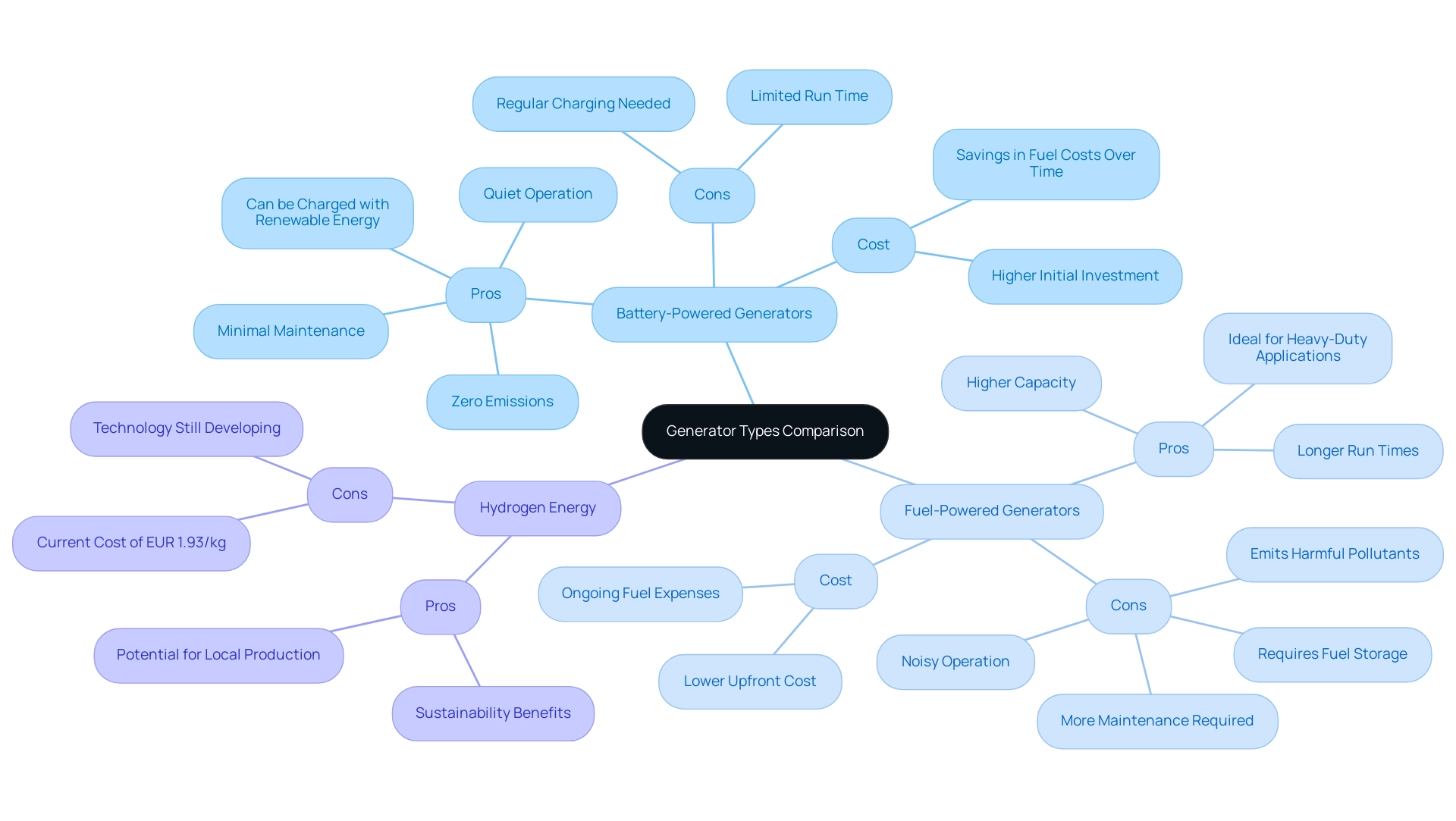Overview
Battery-powered generators for homes are increasingly popular due to their eco-friendly features, versatility, and ability to provide reliable power during outages or outdoor activities. The article discusses essential factors such as capacity, portability, and maintenance practices that homeowners should consider when selecting a unit, emphasizing how these generators can effectively enhance energy resilience while contributing to sustainable living.
Introduction
In an age where energy resilience and sustainability are becoming increasingly important, battery-powered generators are stepping into the spotlight as a modern solution for homeowners. These innovative devices not only provide a reliable source of power during outages but also align with the growing trend towards eco-friendly living.
With their ability to harness stored energy efficiently, battery-powered generators are perfect for everything from emergency backup to powering outdoor events. As technology advances, understanding their features, benefits, and limitations becomes essential for homeowners eager to make informed choices about their energy needs.
This article explores the ins and outs of battery-powered generators, offering insights that can help navigate the shift towards a more sustainable energy landscape.
Introduction to Battery-Powered Generators: A Modern Solution for Home Power Needs
Homeowners who are environmentally aware have quickly favored battery powered generators for houses to improve their power resilience. These innovative devices efficiently convert stored electrical power from batteries into usable power, making them ideal as a battery powered generator for house use, whether for providing emergency backup during outages or for powering outdoor events. As we collectively shift towards eco-friendly options, a battery powered generator for house use emerges as a clean, quiet, and efficient solution for our power requirements.
They not only help reduce our carbon footprint but also align seamlessly with the growing demand for sustainable living practices. With advancements in battery technology continually emerging, the battery powered generator for house is reshaping our approach to home power solutions. It’s crucial to consider, however, that while they offer many advantages, the lower capacity of portable power stations compared to diesel generators may limit their use, particularly for energy-intensive appliances.
This is particularly pertinent as global power consumption trends change, highlighting the urgent need for alternative power solutions. As Robert Metcalfe, Editor, observes, ‘The shift towards sustainable power solutions is not just a trend; it is a necessity for our future.’ By understanding both the benefits and limitations of a battery powered generator for house, homeowners can make informed choices that contribute to a sustainable power landscape.
Furthermore, exploring the best battery choices—such as lithium-ion batteries known for their efficiency and longevity—and eco-friendly cleaning options, like biodegradable cleaners, is essential for maintaining energy systems. Powercore Electric provides extensive services to help homeowners choose the appropriate solar battery options and ensure their solar panels stay clean and efficient, ultimately maximizing output.
Key Features to Consider When Choosing a Battery-Powered Generator
When selecting a battery-powered device, it’s essential to focus on several key features that will ensure you choose the right unit for your needs:
- Capacity: First and foremost, consider the wattage of the equipment. For instance, a unit rated at 1,000 watts can comfortably run a 100-watt device for about 10 hours. Higher capacity means you’ll have the power to operate multiple essential devices during outages, providing peace of mind when you need it most. Additionally, it’s important to consider that to avoid prolonged power consumption, the device has a sleep time, which can enhance energy efficiency.
- Portability: If you envision using your power source for outdoor adventures or emergency situations, opt for a lightweight model that includes wheels for easy transport. This feature can make a significant difference in how easily you can relocate your device when needed.
- Charging Options: Look into the various charging methods available. Some devices provide the flexibility to charge through solar panels, car ports, or standard outlets. This versatility ensures you can keep your power source powered up no matter where you are.
- Run Time: Understanding how long your device can operate on a full charge is crucial. A longer run time means less worry during extended outages, allowing you to maintain comfort in your home. For example, the Onite 5W warm white USB LED light bulb, which is suitable for outdoor use and priced at $9.99, can be easily powered by a portable power source, showcasing practical usage of its capacity.
- Fast Charging Capabilities: Consider models like the VTOMAN Flashspeed 1500, which features one of the fastest charge rates observed. This can be especially advantageous if you need to swiftly recharge your device during a crisis.
By considering these features, you’ll be well-prepared to select a battery-operated unit that fulfills your specific requirements while ensuring you remain connected and powered up when it matters most.
Practical Uses of Battery-Powered Generators: From Emergencies to Outdoor Adventures
Battery-operated devices are incredibly versatile, making them a valuable addition to any home. In fact, there has been an observed increase in sales of battery powered generators for house use in the U.S., indicating a rising private demand for energy resilience. Here are some key ways they can enhance your life:
- Emergency Power Backup: When the lights go out, these generators step up to keep essential devices running—think lights, refrigerators, and even crucial medical equipment. This ensures your family stays safe and comfortable during those unexpected outages.
- Outdoor Activities: Planning a camping trip or a tailgate party? Battery-operated units can supply energy for everything from lights to cooking appliances and even charging stations for your devices. They truly enhance your outdoor adventures, making them more enjoyable and convenient.
- Home Improvement Projects: Tackling a home improvement project away from traditional power sources? These battery powered generators for house supply the electricity necessary for tools and equipment, enabling you to work efficiently and effectively. Whether it’s a DIY project in the backyard or a renovation indoors, you’ll find them to be a game-changer.
As highlighted by a spokesperson from one of the largest firms in the defence sector, “The information on power solutions is quite thorough and precisely what I sought,” emphasizing the significance of dependable power sources such as portable power units in today’s world.
Battery-Powered vs. Fuel-Powered Generators: Pros and Cons
When you’re weighing the options between battery-powered and fuel-powered generators, it’s essential to explore their real-world advantages and drawbacks while considering the efficiency of solar energy, especially on cloudy days:
-
Battery-Powered Generators:
- Pros: These generators are celebrated for their quiet operation, minimal maintenance needs, and zero emissions, making them a top choice for eco-conscious homeowners. They can be conveniently charged using renewable energy sources, like solar panels, enhancing their sustainability appeal even on overcast days.
- Cons: However, battery-powered generators typically come with limited run time and capacity compared to their fuel-powered counterparts. Regular charging is necessary to ensure they’re ready when you need them.
- Cost: The initial investment for battery-powered generators can be higher, but they often lead to savings in fuel costs and maintenance over time.
-
Fuel-Powered Generators:
- Pros: Fuel-powered generators usually offer higher capacity and longer run times, making them ideal for heavy-duty applications. They can easily power larger appliances, which is crucial during extended outages when continuous power is essential.
- Cons: These generators do have their downsides. They tend to be noisy, require dedicated fuel storage, and emit harmful pollutants. Additionally, they need more maintenance, including oil changes and careful fuel management to ensure optimal performance.
- Cost: Generally, fuel-powered generators have a lower upfront cost compared to battery-powered options but incur ongoing fuel expenses.
As you consider alternative energy sources, it’s worth mentioning that hydrogen is gaining traction as a viable option, currently costing EUR 1.93 (USD 2.27) per kilogram. This financial perspective is critical when evaluating the long-term sustainability of your power choices. Hormoz Marzbani’s research emphasizes the progress in hydrogen powertrains, indicating considerable potential in contrast to systems powered by batteries.
Additionally, a case study on small-scale local hydrogen production utilizing renewable sources demonstrates how communities can enhance sustainability and lessen dependence on fossil fuels. This example highlights the increasing significance of incorporating various energy solutions.
In conclusion, the decision between electric and fuel-operated systems, along with developing hydrogen options, relies on your particular energy requirements and way of life. A thorough understanding of each option’s nuances, combined with insights into panel performance on cloudy days and a clear cost comparison, will empower you to make informed decisions that align with your eco-friendly values.
Maintenance and Best Practices for Optimal Performance of Battery-Powered Generators
To maintain your energy-efficient device running smoothly and effectively, while also enhancing your photovoltaic panel system, consider these essential maintenance best practices:
-
Regular Charging: It’s crucial to keep your device charged, especially if an emergency strikes. Regularly check the battery level and avoid letting it completely discharge, as this can lead to reduced performance over time. Connecting your power source with a photovoltaic system can improve autonomy, as it enables you to utilize renewable resources to maintain your power source charged when the grid is unavailable.
-
Inspect Connections: Make it a habit to examine all connections and cables for signs of wear or corrosion. A quick visual check can save you from unexpected outages. If you notice any build-up, don’t hesitate to clean the terminals to ensure a reliable connection. Comprehending the dynamics of your photovoltaic panel system and how it interacts with your power source can help you appreciate the role of a battery powered generator for house systems in a landscape dominated by investor-owned utilities.
-
Store Properly: When your power source isn’t in use, store it in a cool, dry location away from direct sunlight. This helps prevent battery degradation and extends the life of your unit. Adequate storage is crucial to guarantee that your battery powered generator for house is prepared when you require it the most, especially when combined with alternative power solutions that offer backup electricity.
-
Perform System Checks: Schedule routine tests to confirm that your power source is functioning as it should. Familiarity with its functions will empower you to troubleshoot any issues effectively. Routine upkeep not only improves performance but also guarantees that your system is prepared to function alongside your panels, maximizing your efficiency.
By adhering to these suggestions, you’ll extend the lifespan of your generator and ensure it’s equipped to deliver power when you require it the most. This proactive approach to maintenance will complement your solar energy setup, ultimately supporting your goal of energy independence.
Conclusion
Battery-powered generators are proving to be an essential component for homeowners looking to enhance their energy resilience while embracing sustainability. Their ability to provide reliable backup power during outages, coupled with their eco-friendly operation, makes them an attractive choice in today’s energy landscape. Understanding key features like capacity, portability, and charging options enables homeowners to select the right generator to fit their unique needs.
From powering essential appliances during emergencies to enhancing outdoor adventures and facilitating home improvement projects, the versatility of battery-powered generators cannot be overstated. While they offer numerous benefits, it’s important to weigh their limitations against fuel-powered alternatives, particularly regarding run time and capacity, to make informed decisions that align with personal energy needs and eco-friendly values.
Proper maintenance and best practices are crucial for optimizing the performance of these generators, ensuring they remain ready for action when needed. Embracing battery-powered generators is not just about keeping the lights on; it’s a step towards a more sustainable future, where cleaner energy solutions play a pivotal role in everyday life. By integrating these innovative devices into homes, individuals contribute to a broader movement toward energy independence and environmental stewardship.


